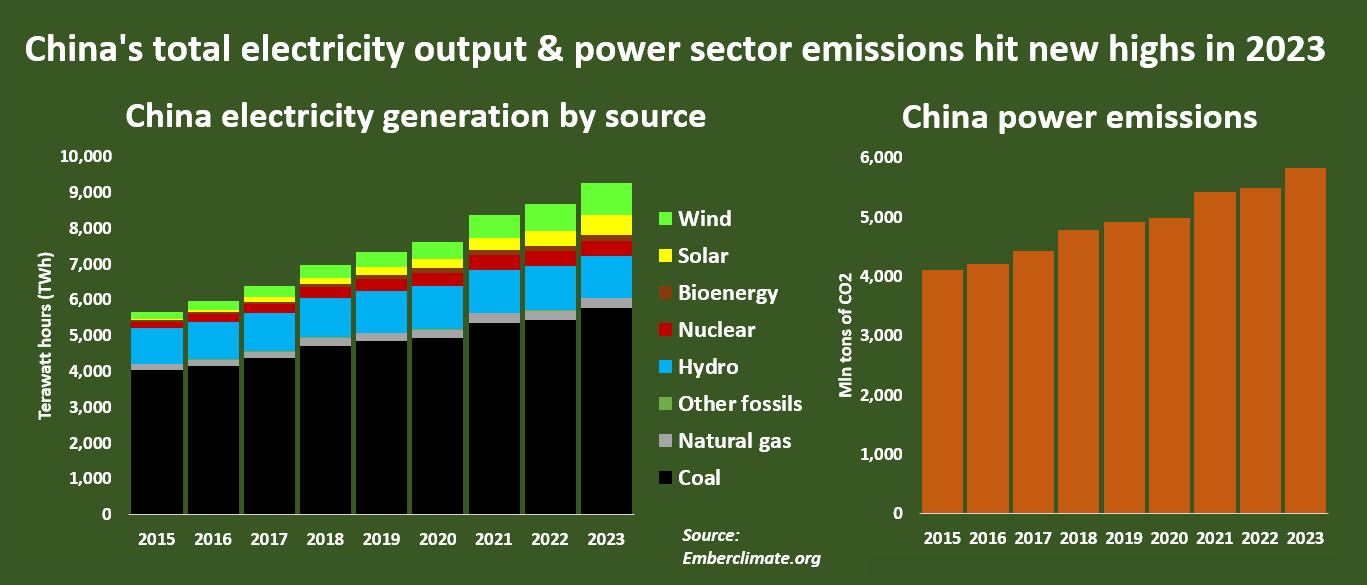Key Takeaways
Despite adding a world record amount of wind and solar capacity in 2023, China’s carbon dioxide emissions from electricity generation increased almost as much as its total electricity generation.
China continues to build coal capacity, adding to its already-enormous fleet of coal generation, generating over 60 percent of the country’s power to supposedly back up its wind and solar generators.
Weather-driven sources such as wind and solar generate power at a fraction of the capacity of their nuclear or fossil fuel generator counterparts.
China continues to increase coal generation in order to manufacture goods for the West, including wind and solar component parts.
China’s carbon dioxide emissions from electricity generation increased nearly 6 percent to a new record in 2023, underlining the country’s status as the world’s largest emitter. The increase came despite huge increases in solar and wind capacity. In fact, China installed more solar panels in 2023 than any other nation has built in total, adding to a massive renewable energy fleet that is leading the world by a wide margin. China added 216.9 gigawatts of solar last year, almost 3 times more than its previous record of 87.4 gigawatts in 2022, and is more than the entire fleet of 175.2 gigawatts in the United States–the world’s second-biggest solar market. China also added 75.9 gigawatts of wind, up more than twice from the 37.6 gigawatts it added last year. But the added solar and wind capacity did not achieve less emissions for they generate less electricity from the same amount of capacity compared to coal, natural and nuclear, as explained below.
China’s total electricity generation increased by 6.6 percent in 2023 from 2022 levels–—the second largest annual increase in electricity generation since 2018. Coal remained the primary power source for electricity with a 62.2 percent share of the generation mix. A slight dip in coal intensity allowed for total power emissions to increase by less than the increase in total electricity generation, increasing 5.96 percent in 2023 to 5.8 billion metric tons of carbon dioxide. Electricity generation from solar sites increased 26 percent and wind generation increased 18 percent, lifting the share of generation from all renewables including the world’s largest hydroelectric generator and its growing nuclear power to 34.5 percent.

China’s Wind and Solar Capacity Explained
China’s increase in renewable capacity helped to reach a world record of 510 gigawatts added last year, according to the International Energy Agency. Last year’s COP28 climate summit had countries agree to triple renewable power by the end of the decade. China probably accounted for 58 percent of global solar installations and 60 percent of global wind installations in 2023.
Regardless of these additions, China is still burning large amounts of coal to generate electricity as mentioned above and increasing its carbon dioxide emissions. China is still adding to its huge fleet of coal-fired power plants, which provide more than 60 percent of the country’s electricity. China insists that new coal plants are needed mainly to serve as back up for intermittent solar and wind generation as it added 57.93 gigawatts of thermal capacity (mostly coal) last year.
Solar and wind installations were spurred in part by steep cost declines as competition among manufacturers pushed prices of panels and turbines in China to record lows. That squeezed profitability for manufacturers and raised expectations of major consolidation across the industry this year.
The acceleration of renewable generation is also creating challenges as China’s grid struggles to keep pace. Some regions face a lack of infrastructure capacity to absorb more solar power and have begun implementing stricter regulations on new projects. Even so, China is expected to sustain the gains in renewable capacity. Solar installations are expected to increase in China by about 7 percent this year, while new wind capacity is expected to increase by 11 percent.
China claims that its installed capacity for wind and solar energy will exceed that of coal for the first time by the end of this year, according to an estimate made by the country’s power trade association, the China Electricity Council. The country’s grid-connected wind and solar power generation capacity could exceed 1,300 gigawatts by the end of this year, with about 530 gigawatts of capacity coming from wind, and 780 gigawatts from solar, increasing their share of capacity to around 40 percent from 36 percent currently.
But, even if wind and solar capacity exceed that of coal, they do not generate the same amount of power as coal. Because of their intermittency, wind and solar produce only 25 percent to 40 percent of the power that coal can produce from the same amount of capacity. As mentioned above, despite the forecast from the China Electricity Council, China faces challenges adding wind and solar capacity to its electric grid due to their intermittency, so all the added capacity may not get grid-connected. Capacity is potential energy; generation is much less as capacity factors for wind and solar are much lower than for thermal plants because the sun does not shine 24 hours per day and the wind does not blow consistently.
China’s Industrial Use and Emissions Remain in Check
China’s property crisis has curbed production of steel and cement that has helped keep overall industrial energy use and emissions in check. Since 2022, China’s output of steel, cement, excavators and other equipment tied to the construction sector have fallen sharply, amplifying its problems caused by the property market slowdown. However, new cuts to bank reserve requirements designed to restore lending to commercial builders are expected to ease some pressure this year, and may revive building activity. If China can restore growth in its domestic property industry, energy use and emissions will increase.

Output and exports of other key manufactured goods including electric vehicles, rechargeable batteries, solar cells and furniture all pushed higher in 2023 and remain on track for further gains in 2024. Increasing global demand for electric vehicles and components tied to the global energy transition is expected to increase China’s global shares in those markets, including the refining and processing of essential minerals necessary for President Biden’s “green transition.”
Conclusion
China added huge amounts of solar and wind capacity in 2023, but that capacity did not lower its carbon dioxide emissions from the power sector as coal still remained its major generator in 2023, supplying over 60 percent of its power. China’s carbon dioxide emissions from the power sector increased by almost 6 percent in 2023, slightly below the increase in generation of 6.6 percent, but still reached a new record. China added the most capacity to global wind and solar capacity additions that reached 510 gigawatts last year, in line with the tripling of renewable capacity by 2030 agreed to at COP28. Much of the additions were due to fierce competition within the solar and wind manufacturing sectors that caused prices to drop. Despite these huge additions to China’s renewable capacity, their generation will remain less than coal as solar and wind capacity factors are much less than that of coal.



